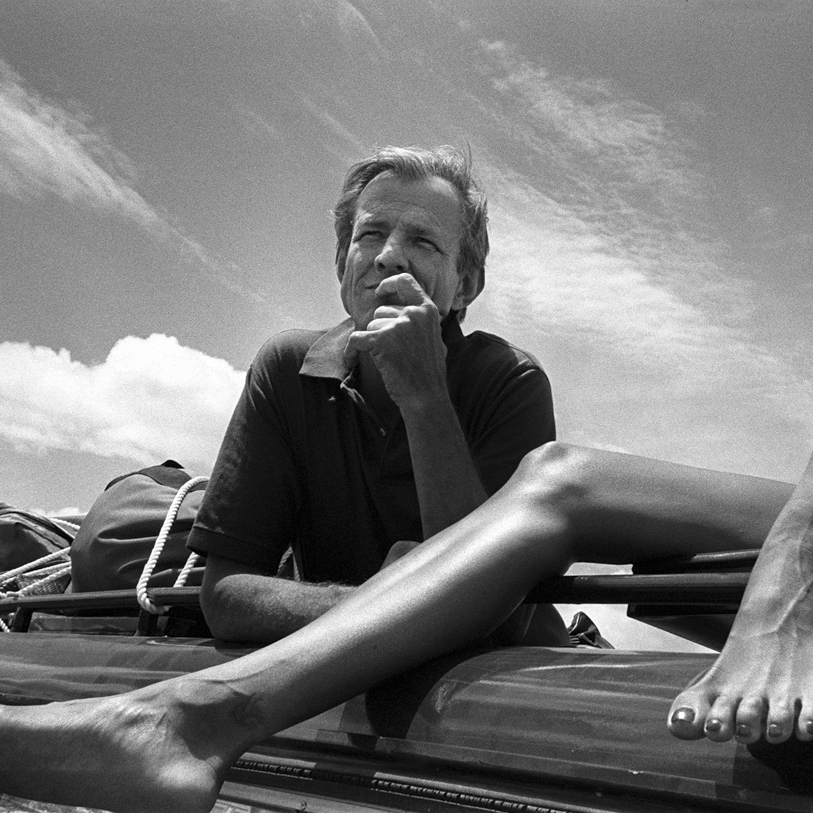Among Peter Beard’s best-known photographs is a self-portrait taken in the 1960s near Lake Turkana, a remote region in northern Kenya where he had traveled with the scientist Alistair Graham to document Graham’s study of Nile crocodiles. In the photo, Peter appears to be hip deep in one of these giant crocodiles, as if he is halfway eaten, and, during a pause in the proceedings, Peter has found time to jot a few notes in his journal. The photo, and various collaged and embellished versions of it, is titled I’ll Write Whenever I Can.
Well before I met Peter, and ages before I started researching and writing his biography, when I was in college, this image of his fascinated me. Here he was, staging himself as a kind of archetype for adventure, braving prehistoric beasts on the far edge of beyond with dash and campy humor—and well aware of his matinee-idol looks (Fran Lebowitz told me that he was the most beautiful straight man she’d ever met), his bright-blond hair, bleached by the hot sun from his days on the lake, shimmering like platinum even in black and white. Indeed, Peter leaps out of the image with the presence of a silent-film star.

Other, equally celebrated versions of this sort of photographic gimmick exist, of course. In 1983, Helmut Newton made a wonderful image of a nude ballerina crawling into the massive mouth of a prop croc that was used in Pina Bausch’s ballet Die Keuschheitslegende, for one.
Here he was, staging himself as a kind of archetype for adventure, and well aware of his matinee-idol looks. (Fran Lebowitz told me that he was the most beautiful straight man she’d ever met.)
But maybe because I saw and fell under the spell of Peter’s picture first, all others seem like they are quoting him. Knowing, too, that the croc in Peter’s picture is real—and that his occupation on the lake of such significance that another of his images from the time, a sober, documentary image of one specimen in Graham’s study, was included by Carl Sagan and the gang on the Voyager Golden Record—gives it an extra little bit of frisson.

At a show of Peter’s work in the early aughts, the poet and filmmaker Jonas Mekas stopped in front of a print of I’ll Write Whenever I Can and chuckled about a story Peter had told him about it, that even though the croc was dead when he climbed into it, the jaw muscles still spasmed and nearly cut him in half.
Jonas and his brother Adolfas had known Peter from before the croc photo was taken, when they cast Peter and his college girlfriend in their film Hallelujah the Hills—in which Peter runs, nude, through deep snow in the Vermont woods, a scene that Andy Warhol would call the first “streak.” Later, in the early 1970s, Peter and his then girlfriend, Lee Radziwill, commissioned the Mekases to help make a documentary about Radziwill’s family in East Hampton, a film that would soon grow and be taken up by the Maysles brothers and become Grey Gardens. They had history is what I’m saying.

Peter and Jonas were quite close, and still I think Peter was absolutely pulling Jonas’s chain. Had been for decades. Because after years of hearing stories about Peter, years of looking at this image, thinking about what it meant, about how it came to be, about how he might have pulled it off—really, look at the picture—I don’t think he is in the crocodile at all.
You learn a lot about someone when writing their biography. Too much, probably. Some of those things, when you are researching and writing about a character like Peter Beard, are incredible, like his climbing Mount Kilimanjaro with a new mistress on acid. Others are less so, like the fact that he had a newborn with his wife Nejma Khanum Beard at the time and hadn’t mentioned either of those details to his new flame. With Peter, there are also bits that are much worse.
Some of the things you learn about your subject are incredible character revelations. But most are just prompts for us to wonder about. Like, were Peter’s lies, smoke screens, and outright deceptions malicious? Was he attempting to lie to himself, and why? Was it all part of the image that he was trying to create, and project, just as he had done by staging the croc to look as if it were gobbling him up?

At various moments during the time I spent reading and writing about him, deciphering the runes of his behavior and the hodgepodge of his relationships, as well as the overwhelming body of work, I found Peter to be a narcissist, perhaps even a sociopath, a profoundly important artist, and a phenomenal expression of entitlement, ambition, fame, flamboyance, vanity, and creativity in the 20th century.
No one is consistent, to be sure, and Peter particularly seemed to relish in zigging when he was expected to zag, in undercutting and confounding all expectations. Lying to friends, embellishing his legend, and living way out on the boundaries of acceptable behavior may not have made him the paragon of honor, but it does make for some pretty good copy.

Christopher Wallace’s Twentieth-Century Man: The Wild Life of Peter Beard will be published on July 4 by Ecco
